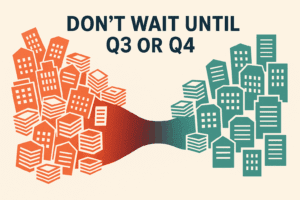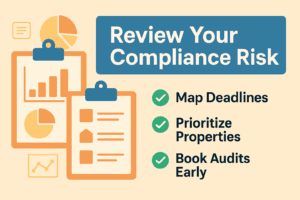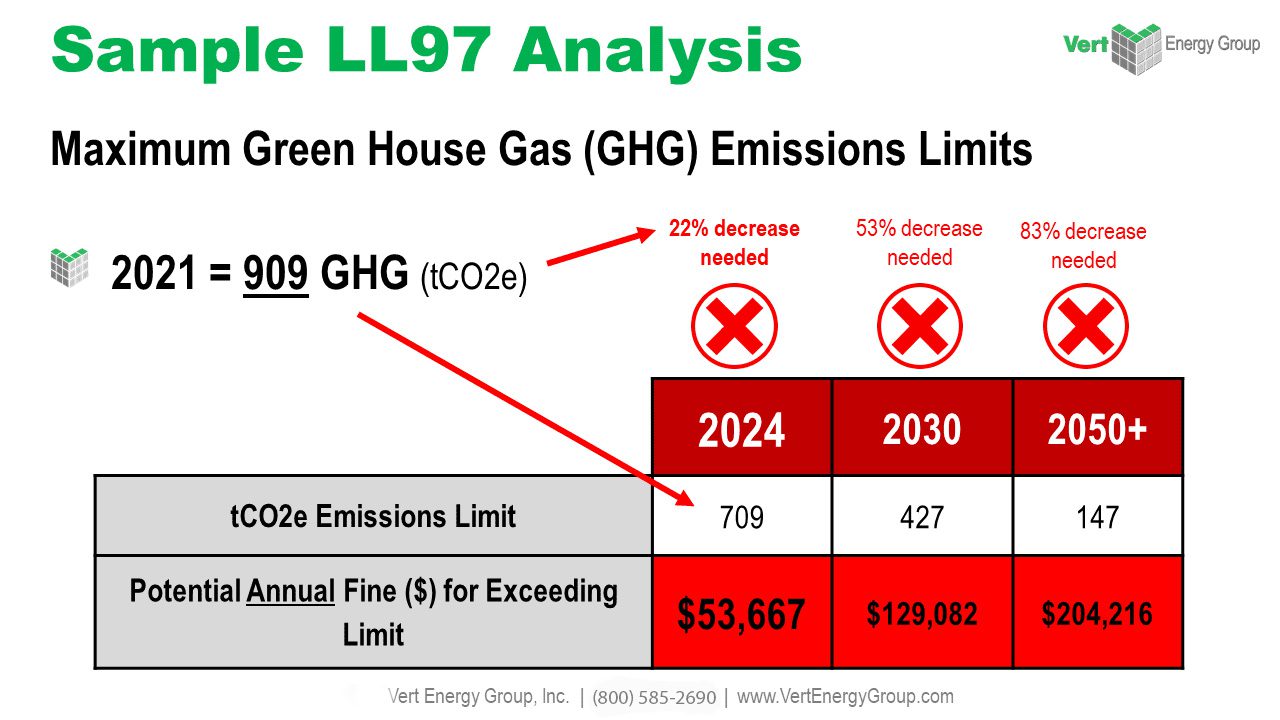DC building owners: Every square foot of your property could cost you $10 if you ignore this deadline.
Washington, DC’s Building Energy Performance Standards (BEPS) are entering a critical phase, and compliance deadlines for 2026 are closer than they seem. Commercial property managers and owners familiar with BEPS now need to shift from awareness to action because DC BEPS compliance 2026 depends on the groundwork you lay today. From Washington, DC benchmarking penalties to navigating the building performance standards DC enforces, early preparation is your strongest defense against costly setbacks.
In the coming months, demand for qualified energy consultants will spike—so acting early is more than smart, it’s necessary. This blog will walk you through three key next steps to get ahead: identifying your building’s baseline under the current DC compliance cycle 2026, creating a customized BEPS report checklist 2026, and scheduling your energy audit or performance improvement plan. By understanding BEPS energy reporting deadlines and how to avoid BEPS fines DC buildings face, you’ll move beyond basic compliance and into long-term resilience.
1. Identify Your Building’s Performance Baseline

Before any improvement strategy can be developed, you must first know where you stand. Washington DC’s Building Energy Performance Standards (BEPS) use your building’s baseline data to determine compliance status under the DC compliance cycle 2026. Buildings that perform below the District’s standard will be subject to performance improvement requirements or face steep penalties.
What’s Involved in Establishing Your Baseline?
- ENERGY STAR Portfolio Manager Data: The District uses ENERGY STAR metrics as part of its benchmarking process. Make sure your data is complete, accurate, and up-to-date.
- Lookback Period: BEPS typically uses a three-year historical average for energy use intensity (EUI). Verify your data from 2021-2023 to ensure no gaps exist.
- Building Type Classification: Your building’s type—office, multifamily, hotel—determines which performance standard applies. Reclassification can affect compliance targets.
Getting this right is critical. An inaccurate or incomplete baseline will affect whether you’re placed in the performance pathway or need to take additional steps to improve. Most importantly, these data set the bar for your required energy savings and how high that bar will be.
Act Early to Save Costs and Stress
If your building doesn’t meet the current standard, you’ll need to prove a 20% site EUI reduction by 2026. That effort takes time, planning, and budget—none of which you’ll have if you wait until late 2025. Establish your baseline today to start mapping your compliance path.
2. Create a BEPS Report Checklist for 2026
Once your baseline is established, the next step is organizing your compliance documentation. This is where a BEPS report checklist 2026 becomes invaluable. With DC’s BEPS energy reporting deadlines approaching, a simple oversight like missing a required data point or audit signature, could mean noncompliance and a potential fine of $10 per square foot.
Key Elements of a BEPS Compliance Checklist
- ✅ Building Profile Documentation
Square footage, occupancy, property type, and systems overview. - ✅ Energy Benchmarking Reports
Data submitted to the DC Department of Energy & Environment (DOEE), verified for accuracy. - ✅ Compliance Pathway Declaration
Owners must select one of several pathways: performance, standard, or prescriptive. - ✅ Third-Party Verification or Audit
A licensed professional must validate data or develop an improvement strategy, depending on your pathway. - ✅ Improvement Plan (if applicable)
Document outlining capital upgrades, retrofits, or operational changes necessary to meet the 2026 targets. - ✅ Progress Reports
Annual updates are required under most pathways, showing progress toward energy goals.
By preparing a checklist early, you reduce the risk of rushing through submission requirements at the last minute. It also helps identify gaps—whether in documentation, strategy, or performance—that need to be addressed now, not later.
3. Schedule Your Energy Audit or Performance Planning
DC building owners that fall short of BEPS thresholds have two primary options: reduce energy use by the required percentage or take prescriptive actions outlined by the DOEE. Either way, an energy audit or performance improvement plan is required, and that’s not something you want to scramble to complete in 2025.
Why You Should Schedule Your Audit Now
- Limited Consultant Availability: As the 2026 deadline approaches, energy consultants and engineers will be in high demand. Waiting increases your risk of missing your planning window.
- Capital Project Lead Time: Many performance upgrades—like HVAC retrofits or lighting overhauls—require procurement, permitting, and installation timelines that can span 12–18 months.
- Financial Planning: Knowing your compliance costs early lets you budget more accurately and explore available rebates or incentives under DC’s energy programs.
What the Audit Should Cover
- Building envelope analysis (windows, insulation, infiltration)
- HVAC systems and controls
- Lighting systems and daylighting opportunities
- Plug load and occupant behavior patterns
- Opportunities for automation and smart building tech
A comprehensive audit or improvement plan doesn’t just satisfy regulatory requirements—it becomes a roadmap for long-term operational savings and higher asset value.
4. Avoid Washington, DC Benchmarking Penalties
Even buildings that eventually meet BEPS performance targets can be fined if they fail to submit annual benchmarking data or update their ENERGY STAR Portfolio Manager. These Washington, DC benchmarking penalties accumulate over time and can trigger enforcement action from the DOEE.
Key Avoidance Steps:
- Ensure your 2024 benchmarking report is filed on time (April 1 deadline annually)
- Check for automatic data upload errors from your utility provider
- Assign responsibility internally or through a consultant to maintain data accuracy
- Keep records of every submission and DOEE confirmation receipt
Benchmarking is the foundation of BEPS compliance. Avoidable fines from late or incorrect submissions are the easiest penalties to eliminate—if you stay organized.
Frequently Asked Questions (FAQ)

- What types of buildings are subject to DC BEPS compliance 2026?
Commercial buildings over 25,000 square feet, including offices, multifamily properties, and hotels, must comply. Smaller buildings will be phased in later.
- How is the performance standard determined?
Each building is compared to a median ENERGY STAR score or energy use intensity (EUI) for its peer group. If your building scores below the standard, improvement is required.
- What happens if I miss the 2026 improvement targets?
Buildings that don’t meet their pathway obligations face fines of up to $10 per square foot, plus potential public disclosure of noncompliance.
- Can I switch compliance pathways mid-cycle?
In most cases, no. Your selected pathway is locked in unless the DOEE approves a significant change. Choose carefully and consult with a compliance expert before declaring.
- Is financial assistance available for BEPS improvements?
Yes. DCSEU and other local organizations offer rebates, incentives, and low-interest financing for qualifying energy efficiency projects.
Final Steps to Stay Ahead of DC BEPS Compliance
You now know what’s at stake with DC BEPS compliance in 2026—and more importantly, how to prepare. From identifying your building’s performance baseline to building a complete BEPS report checklist and scheduling your energy audit, every step you take today helps avoid Washington DC benchmarking penalties and steep $10-per-square-foot fines. BEPS isn’t just a regulatory hurdle. It’s a roadmap to a more efficient, valuable property. Early action means fewer surprises, lower costs, and a smoother path to compliance under the DC compliance cycle 2026.
Don’t wait until deadlines tighten or consultants are booked solid. Sign up now for a free consultation session with one of our BEPS experts. We’ll help you review your data, flag compliance gaps, and create a custom plan that keeps your building ahead of the curve. DC building owners: Start your 2026 compliance now. File your BEPS report early. Avoid enforcement headaches and stay in control of your portfolio’s performance.
VertPro’s tools are purpose-built to simplify benchmarking and BEPS compliance for DC buildings. From instant audit pricing to compliance tracking, we help ensure your data, reports, and improvement plans are not just submitted, but submitted right.















